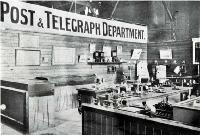The Post and Telegraph Department Court and the Exhibition Post Office
- Included in the Exhibition was a fully operational post office and savings bank which was very popular with visitors.
- A working telegraph office also allowed visitors to send telegrams and view historic and new telegraphic equipment.
Wired for sound
The Post and Telegraph Department had its own Court, with a comprehensive collection of both historical and modern telegraphic and telephonic equipment on display. The walls were decorated with stamps mounted in frames. Of particular interest was a small installation of a Marconi plant erected by the Marconi Company’s Australian representative, Captain L.E. Walker. One of the Company’s engineers, H.N. Dowsett gave the first public demonstration of radio in New Zealand, sending and receiving messages from a similar installation placed in Islington and from British warships outside Lyttelton Harbour.
Excellent trade
The Department also opened a post office and savings bank on the Exhibition site on 22 October 1906. The following day a telegraph office was opened. Both closed on 20 April 1907. These offices did an excellent trade during the Exhibition.
Received for delivery were:
- 296,480 letters
- 300 registered articles
- 6450 lettercards
- 8700 post cards
- 610 parcels
- 7690 packets
- 15,000 newspapers
Sent from the Post Office were:
- 187,200 letters
- 1236 registered articles
- 5320 lettercards
- 340,000 postcards
- 750 parcels
- 12,000 packets
- 11,409 newspapers
In addition 9,800 telegrams valued at £240, 10s and 6d were received and 14,514 telegrams valued at £568, 8s 2d were sent. Overall, Christchurch postal business increased by some 25% during the months of the Exhibition.
Stamps
A special set of four commemorative stamps was issued on 1 November for sale only by the Exhibition post office, which also had its own date-stamp, "Exhibition Christchurch". The stamps featured designs by Auckland artist and engraver, Louis John Steele, some of whose works were also on display in the Colonial Art gallery. The 1/2d stamp showed the arrival of the Māori in the canoe Te Arawa, the 1d stamp Māori carvings, the 3d stamp the landing of Captain Cook in Poverty Bay and the 6d stamp (which was not issued until 16 November) the hoisting of the British flag in Kororāreka.
![]()
Related photos
 Exhibits of telegraphic apparatus |
Sources
- Appendix to the Journals of the House of Representatives, 1907, F-1, p. vii - annual report of Post and Telegraph Dept
- Cowan, J. Official record of the New Zealand International Exhibition of Arts and Industries held at Christchurch, 1906-7, page 140 -141
- Di Somma, M. New Zealand collection: 150 years
- Thackery, T.C. NZ first day and early use covers




